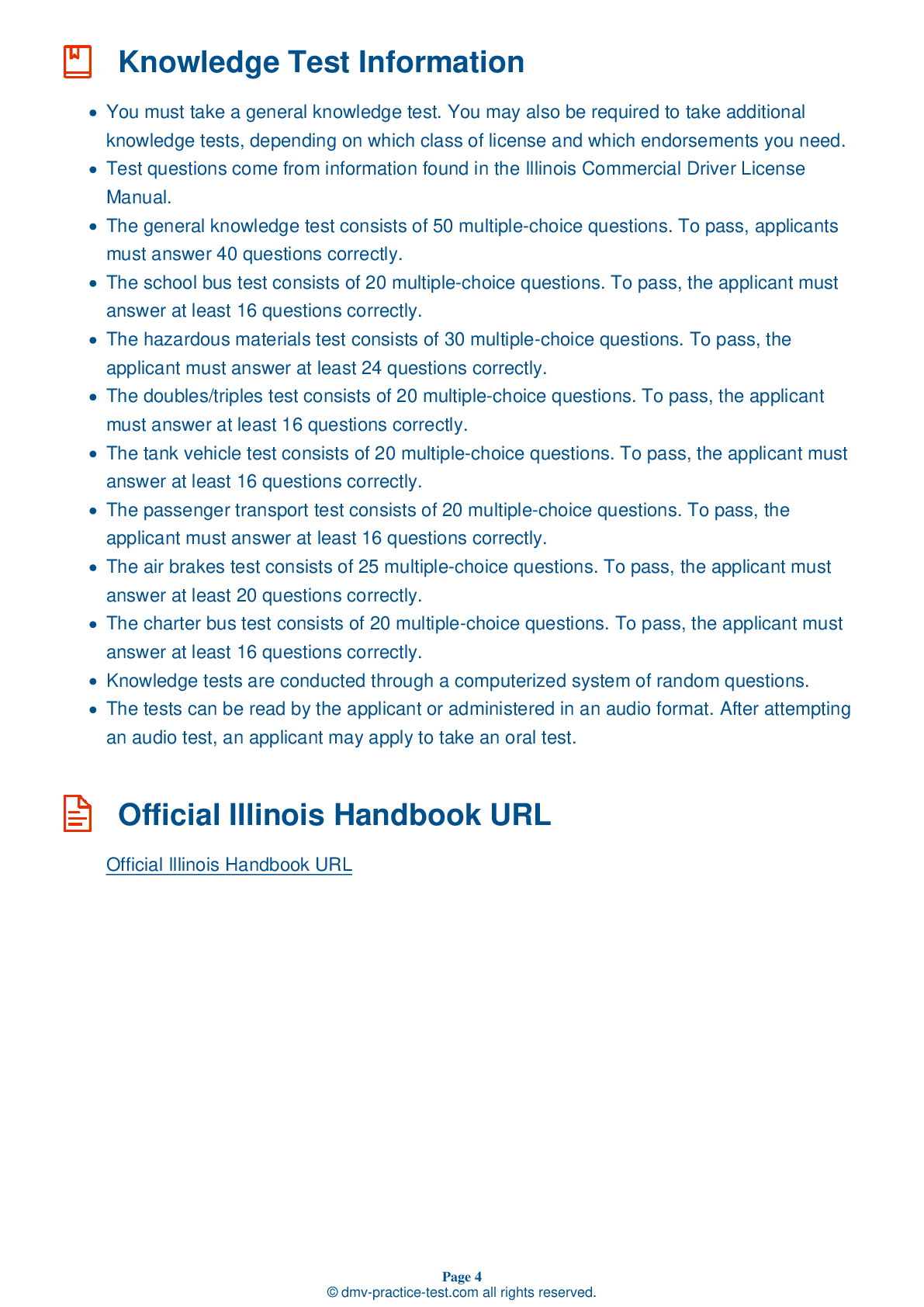Combination #1
Combination Vehicles Practice Test | Illinois 2025 #1 Page 3 of 3
Train for FREE online with our Illinois CDL combination vehicle test. The official exam test consists of several obligatory parts, with all of them checking your knowledge of different blocks of road rules. If you need to obtain a IL combination license in 2025, practice as much as possible. Free sample tests published on our website will help you check and improve your knowledge and boost your grades. Please bear in mind that DMV requirements for issuing a combination license may vary from state to state.
20
16
20
15 . When a combination vehicle goes around a corner:
It is acceptable for street signs to be knocked over if they are too close to the road.
When a vehicle goes around a corner, the rear wheels follow a different path than the front wheels. This is called off-tracking. This effect is especially pronounced on vehicles with trailers.
16 . If colors are being used to distinguish glad hands, which color is used for emergency lines?
Red
When trailer air lines are color-coded, the service lines are generally blue and the emergency lines are generally red.
17 . To prevent a trailer from rolling over, you should:
Drive slowly around corners.
To reduce the risk of a rollover when driving a combination vehicle, you should keep the weight of the cargo as low to the ground as possible and drive slowly around turns.
18 . When lightly loaded, combination vehicles:
Should be loaded with most of the weight in the rear of the trailer.
When a combination vehicle is lightly loaded, it may have poor traction. It is very easy for wheels to lock up on lightly-loaded vehicles when they are being stopped.
19 . When backing up to couple a trailer, you should position the tractor:
At a 60-degree angle in front of the trailer.
When backing up to couple a trailer, you should position the tractor directly in front of the trailer. Trying to couple while backing at an angle could cause the trailer to move and the landing gear to break.
20 . Starting in which year were newly manufactured trailers required to have ABS?
2004
All trailers and converter dollies manufactured on or after March 1, 1998 must be equipped with Anti-Lock Braking Systems (ABS).
2025 Illinois | Frequently Asked Questions
To acquire a CDL Tank endorsement in Illinois, you must first have a Commercial Driver's License (CDL). Next, study the Tank Vehicles section of the Illinois Commercial Driver's License Study Guide. Once prepared, schedule and pass the written tank vehicle endorsement test at a Secretary of State Driver Services facility. The endorsement will then be added to your CDL.
To obtain a CDL Tank license, it is essential to have a Commercial Driver's License (CDL) first. Then, you need to study the Tank Vehicles section of the Illinois Commercial Driver's License Study Guide. After studying, you must pass the written tank vehicle endorsement test at a Secretary of State Driver Services facility in Illinois.
While specific training or experience isn't legally mandatory for a CDL Tank endorsement in Illinois, it is highly recommended. Understanding the operation of tank vehicles and handling of liquid cargo is crucial. Studying the Tank Vehicles section of the Illinois Commercial Driver's License Study Guide and passing the written test at a Secretary of State Driver Services facility is required.
Yes, to obtain a CDL Tank endorsement in Illinois, you must pass an additional written test. This test covers specific knowledge related to the safe transport of liquid and gaseous materials in tank vehicles. The information for the test can be found in the Tank Vehicles section of the Illinois Commercial Driver's License Study Guide.
The written test for the CDL Tank endorsement in Illinois covers various subjects including: high and low center of gravity and its impact on vehicle stability, how to inspect tank vehicles, how to drive vehicles loaded with liquids or gases, and special safety considerations for hazardous materials. All these subjects are detailed in the Illinois Commercial Driver's License Study Guide.
The CDL Tank endorsement assessment evaluates your understanding of tank-specific operations. You'll be tested on handling liquid surge, inspecting tank vehicles, managing a high center of gravity, and the implications of carrying a full or partial load. However, it's primarily a knowledge test, so specific driving maneuvers aren't typically assessed in this endorsement.
Yes, drivers with a CDL Tank endorsement must comply with specific requirements and regulations. These include maintaining a clean driving record, undergoing regular medical examinations, and adhering to hours-of-service regulations. Additionally, drivers must follow safety procedures when loading and unloading tanks, and comply with hazardous materials transportation regulations if applicable.
No, you cannot legally transport liquid or gas materials without a valid CDL Tank endorsement in Illinois. This endorsement is necessary for operating a commercial vehicle designed to transport any liquid or gaseous materials within a tank or tanks having an individual rated capacity of more than 119 gallons and an aggregate rated capacity of 1,000 gallons or more.
Yes, the CDL Tank endorsement can be added to your current license in Illinois. You don't need to apply for a fresh license. However, you must pass the Tank Vehicle endorsement test. Once passed, the endorsement will be added to your existing CDL, allowing you to legally operate tank vehicles.
Yes, handling hazardous materials with a CDL Tank endorsement requires adherence to specific regulations. Drivers must pass the Hazardous Materials (HazMat) endorsement knowledge test, undergo a federal background check, and submit fingerprints. They must also follow safety protocols for loading and unloading hazardous materials, and comply with shipping paper requirements.



